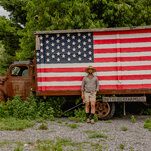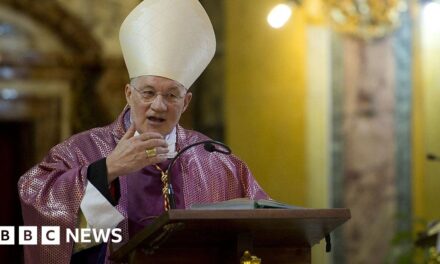
A Fourth of July Symbol of Unity That May No Longer Unite

In a Long Island town, neighbors now make assumptions, true and sometimes false, about people who conspicuously display American flags.


SOUTHOLD, N.Y. — The American flag flies in paint on the side of Peter Treiber Jr.’s potato truck, a local landmark parked permanently on County Route 48, doing little more, he thought, than drawing attention to his family’s farm.
Until he tried to sell his produce.
At a local greenmarket where he sells things like wild bergamot, honey and sunflowers, he had trouble striking a deal until, he said, he let his liberal leanings slip out in conversation with a customer.
“She said, ‘Oh, whew. You know, I wasn’t so sure about you, I thought you were some flag-waving something-or-other,’” Mr. Treiber, 32, recalled the woman saying and citing his potato truck display. “That’s why she was apprehensive of interacting with me.”
He paused: “It was a little sad to me. It shows the dichotomy of the country that a flag can mean that. That I had to think, ‘Do I need to reconsider having that out there?’”
Thirteen stripes, a dusting of stars, the American flag has had infinite meanings over the 244 years since the country began flying one. Raised at Iwo Jima, it was a symbol of victory. Lit on fire, it became a searing image of the protests against the Vietnam War. Ribboned around the twin towers on commemorative Sept. 11 lapel pins, it is a reminder of the threats against a delicate democracy.
Politicians of both parties have long sought to wrap themselves in the flag. But something may be changing: Today, flying the flag from the back of a pickup truck or over a lawn is increasingly seen as a clue, albeit an imperfect one, to a person’s political affiliation in a deeply divided nation.
Supporters of former President Donald J. Trump have embraced the flag so fervently — at his rallies, across conservative media and even during the Jan. 6 assault on the Capitol — that many liberals like Mr. Treiber worry that the left has all but ceded the national emblem to the right.
What was once a unifying symbol — there is a star on it for each state, after all — is now alienating to some, its stripes now fault lines between people who kneel while “The Star-Spangled Banner” plays and those for whom not pledging allegiance is an affront.
And it has made the celebration of the Fourth of July, of patriotic bunting and cakes with blueberries and strawberries arranged into Old Glory, into another cleft in a country that seems no longer quite so indivisible, under a flag threatening to fray.
Mr. Treiber’s farm is in the town of Southold, a string of hamlets and a village on the North Fork of Long Island’s Suffolk County. The county chose Mr. Trump for president in 2020 by just 232 votes out of more than 770,000 cast.
Southold is predominantly white, with a small, longstanding Black population — families who reside mostly in the village, Greenport, at the edge of the salty Peconic Bay. There is also a significant Latino population, many of them undocumented, their labor underpinning the vineyards, farms and landscaping businesses that line the peninsula.
The pressure to draw partisan lines is fierce.
Image

Just across the street from Treiber Farms, David Surozenski, 66, was weeding around the flagpole in his front yard a few days before the Fourth of July. Bouquets of miniature American flags flapped among the marigolds at his feet. Above him flew the flags of the Marines and the Coast Guard — he has children in each service — and at the top, an American flag.
A Republican, Mr. Surozenski said friends constantly pressured him to add Trump banners to his flag-and-flower garden, to fly “Make America Great Again” signs between his red, white and blue pinwheels whirling in the grass. But Mr. Surozenski declined — some of his eight children are Democrats.
“They said, ‘Dave, you’ve got to put Trump’s flag up!’ and I said, ‘No, that’s not happening,’” Mr. Surozenski recalled. “That’s not the way I was brought up. The American flag political? No.”
About 70 percent of Americans say the flag makes them feel proud, according to a recent survey by YouGov, a global public opinion and data research firm, and NBCLX, a mobile information platform. The sentiment was shared by about 80 percent of white Americans, just under 70 percent of Hispanic Americans and slightly less than 60 percent of Black Americans.
The divisions were deeper when it came to politics. While 66 percent of Republicans surveyed said they associated the flag with their own party, only 34 percent of Democrats said the same.
At its 1777 inception, the flag’s very design signified unity, the joining of the 13 colonies, said John R. Vile, a professor of political science and a dean at Middle Tennessee State University.
Politicizing the American flag is thus a perversion of its original intent, according to Professor Vile, who is also the author of “The American Flag: An Encyclopedia of the Stars and Stripes In U.S. History, Culture and Law.” He added, “We can’t allow that to happen.”
“It’s E Pluribus Unum — from many, one,” he said, citing the Latin motto on the Great Seal of the United States. “If the pluribus overwhelms the unum, then what do we have left?”
The sentiment of some conservatives is that a line was drawn when Colin Kaepernick, the former National Football League quarterback, set off a national movement protesting the shootings of Black men by police by taking a knee during the anthem in 2016. His kneeling protest, Mr. Kaepernick has said, still demonstrated respect for the flag, but others saw him as hijacking the flag for political purposes.
Maryneily Rodriguez, 33, said she believed that Mr. Trump’s most fervent supporters had done the same. Ms. Rodriguez, who was visiting Greenport with her fiancé during the Fourth of July weekend, said that she once regularly flew the flag at her home in Freeport, about 80 miles west on Long Island, taking it down only in winter for safekeeping. But about three years ago when spring came, Ms. Rodriguez, who is Black and a Democrat, left the flag in storage. It hasn’t come out since.
“It felt like it didn’t belong to me anymore,” she said.
John Hocker, a Republican who said he sometimes votes Democratic, also said he felt the flag had lost its meaning of unity. Instead of saluting the same flag as one people, he said, too many Americans were modifying it to become emblems of their own identities or belief systems, for instance with rainbow stripes, a symbol of gay pride, or blue stripes to show solidarity with the police.
He flies the flag — the red, white and blue one — from a towering crane several stories above the gravel piles of Latham Sand & Gravel, where he is a co-owner.
“There is a lot of history with this country, some that maybe people don’t like today, and some that people are being judged for today for what they did 300 years ago,” he said.
“It’s still our country and every good and bad thing made it our country,” Mr. Hocker said, glancing upward. “And that’s what that represents.”
The culture war he was alluding to was on full display a few miles away, hanging from the eaves of an empty roadside stand: “SAVE AMERICA” was printed along the flag’s top border, and below: “FIGHT SOCIALISM.”
And on a notice tacked nearby: “If this offends you LEAVE.”
Image
At Rinconcito Hispano in Greenport, Ana Perez, 33, served up pupusas, stuffed masa flour patties from her native El Salvador, to customers who ordered exclusively in Spanish. Many of them are the laborers who clean the pools at the beach houses and scare the crows off the grapes at the wineries.
In 2017, as Mr. Trump began his crackdown on illegal immigration, village trustees unanimously adopted a resolution to declare Greenport “a welcoming community.” One resident opposing the measure at the meeting urged the public to call and report anyone who employed undocumented immigrants. Wearing an American flag on his chest, he held up a sign with a phone number.
Ms. Perez said she has an American flag T-shirt, too, and she intended to wear it on the holiday. “This symbolizes this country, and I live in this country,” she said, speaking in Spanish because she is not fluent in English. “This flag is for all.”
Image
Strolling with her fiancé, Anthony Dipolito, Ms. Rodriguez took in the 1920 wooden carousel beside the marina in Greenport.
As she crossed through Mitchell Park, she was struck by the sight of a forest of American flags. It was not a prop for a political rally, but rather a peaceful “field of honor” installed by the Greenport Rotary Club.
Each flag represented not an ideological belief, according to the club, but a veteran or other citizen who had inspired or helped the community.
“I’ve always loved the American flag so much, and now seeing it by the carousel I felt happy again,” Ms. Rodriguez said, as all around her red, white, and blue cloth still waved. “And I haven’t felt that way about the flag in such a long time.”
Correction: July 3, 2021
Because of an editing error, an earlier version of this article referred incorrectly to an organization that had installed a flag display. It was the Greenport Rotary Club, not the Greenpoint Rotary Club.
Source: https://www.nytimes.com/2021/07/03/nyregion/american-flag-politics-polarization.html


















